Background
“Coming out” about one’s sexual orientation – or deciding to share aspects of one’s sexual, physical, romantic, and emotional attractions with other people —is a deeply personal decision. Choosing not to come out as LGBTQ or only sharing one’s identity with a few trusted people are just as valid as coming out to everyone in one’s life. It is also important to recognize that coming out is often a dynamic process in which people may find themselves coming out in new environments or coming out again if there is a change in how they identify. Youth’s outness is associated with mixed mental health outcomes. While being out may provide youth with access to accepting and affirming connections with people who share their identities, a strong protective factor against poor mental health (Kosciw et al., 2015), being out also opens youth up to the potential rejection and harm that comes with others knowing their sexual orientation (Meyer et al., 2021; Poteat, 2021). Age may help to explain this complexity, as outness has been associated with greater suicidal ideation for adolescents ages 12-17, but not for emerging adults ages 18-24 (Feinstein et al., 2022). Additionally, younger generations of LGBTQ youth are coming out at younger ages, potentially putting them at greater risk for victimization at a time when they may be less equipped to handle it. That said, very little research specifically examines the intersection of these hypotheses. Using data from The Trevor Project’s 2022 National Survey on LGBTQ Youth Mental Health, this brief examines the association between LGBTQ youth’s age of coming out about their sexual orientation and suicide risk.
Results
LGBTQ youth are coming out about their sexual orientation at younger ages. LGBTQ youth in our sample who were aged 13-17 came out, on average, at age 13 (M=13.17; SD=16.26), compared to LGBTQ youth ages 18-24 who came out, on average, at age 16 (M=16.26; SD=2.89). Overall, 24% of the sample came out before 13 years old. However, 35% of LGBTQ youth ages 13-17 came out before they were 13 years old compared to only 8% of LGBTQ youth ages 18-24.
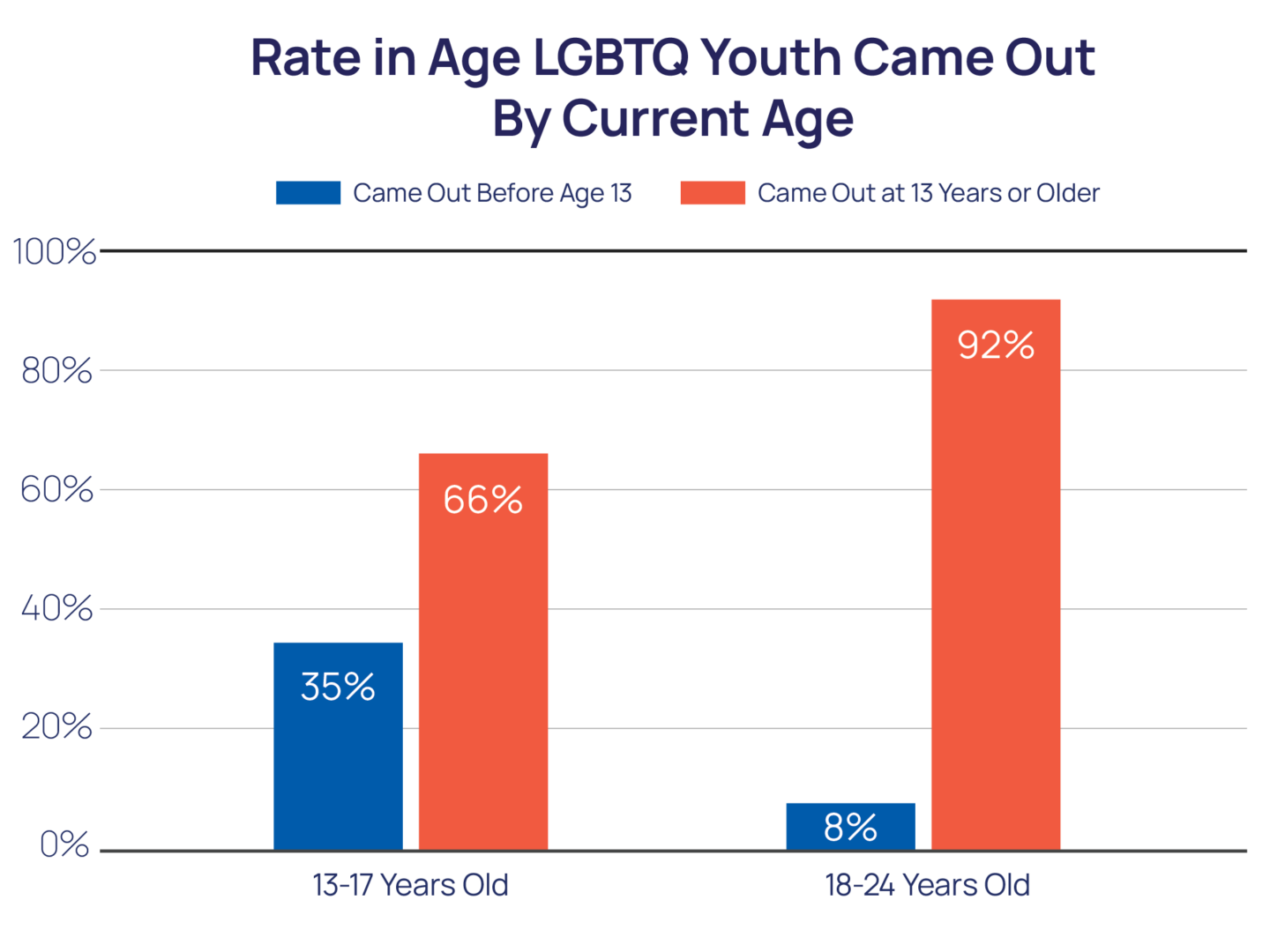
LGBTQ youth who came out before age 13 had increased odds of suicide risk. More than half of LGBTQ youth who came out before age 13 (56%) seriously considered suicide in the past year, compared to 42% of youth who came out later. Additionally, 22% of LGBTQ youth who came out before age 13 attempted suicide in the past year, compared to 12% of those who came out later. LGBTQ youth who came out at age 13 or younger had 37% increased odds of a suicide attempt in the past year (aOR=1.37).
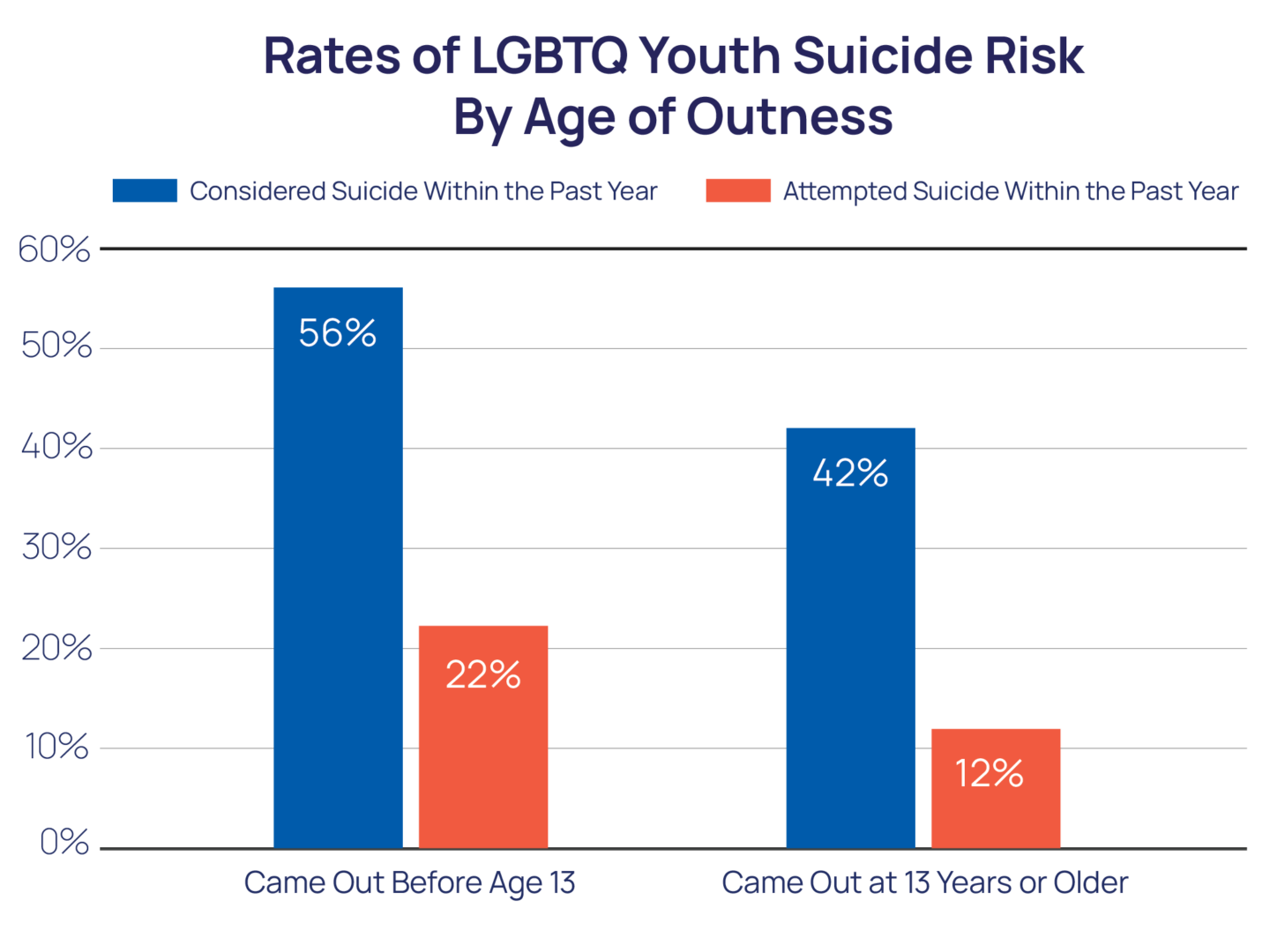
LGBTQ youth who came out about their sexual orientation before age 13 reported higher rates of victimization due to their sexual orientation or gender identity. Nearly half (46%) of LGBTQ youth who came out before age 13 reported that they have been physically threatened or harmed due to their sexual orientation or gender identity, compared to 34% of LGBTQ youth who came out after age 13. Additionally, 83% of LGBTQ youth who came out at age 13 or younger reported that they have experienced discrimination based on their sexual orientation or gender identity, compared to 72% of LGBTQ who came out later.
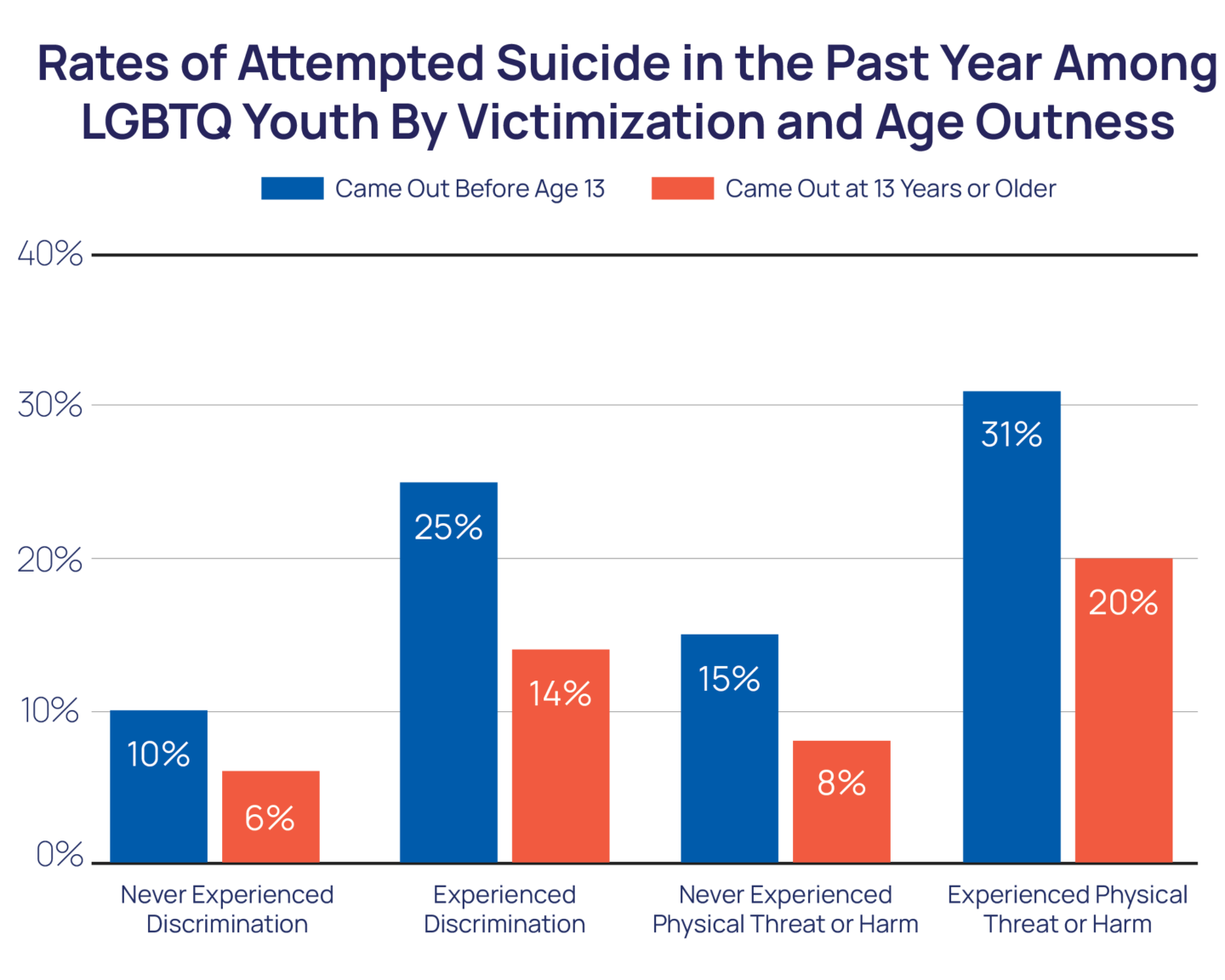
LGBTQ youth who came out about their sexual orientation before age 13 and experienced victimization reported higher rates of attempting suicide compared to LGBTQ youth who came out before age 13 but did not experience victimization. LGBTQ youth who came out before age 13 and experienced physical threat or harm due to their sexual orientation or gender identity reported twice the rate of attempting suicide in the past year (31%) compared to LGBTQ youth who came out before age 13 but did not experience physical threat or harm (15%). Furthermore, LGBTQ youth who came out before age 13 and experienced discrimination based on their sexual orientation or gender identity reported more than twice the rate of attempting suicide in the past year (25%) compared to their peers who also came out before age 13, but did not experience discrimination (10%).
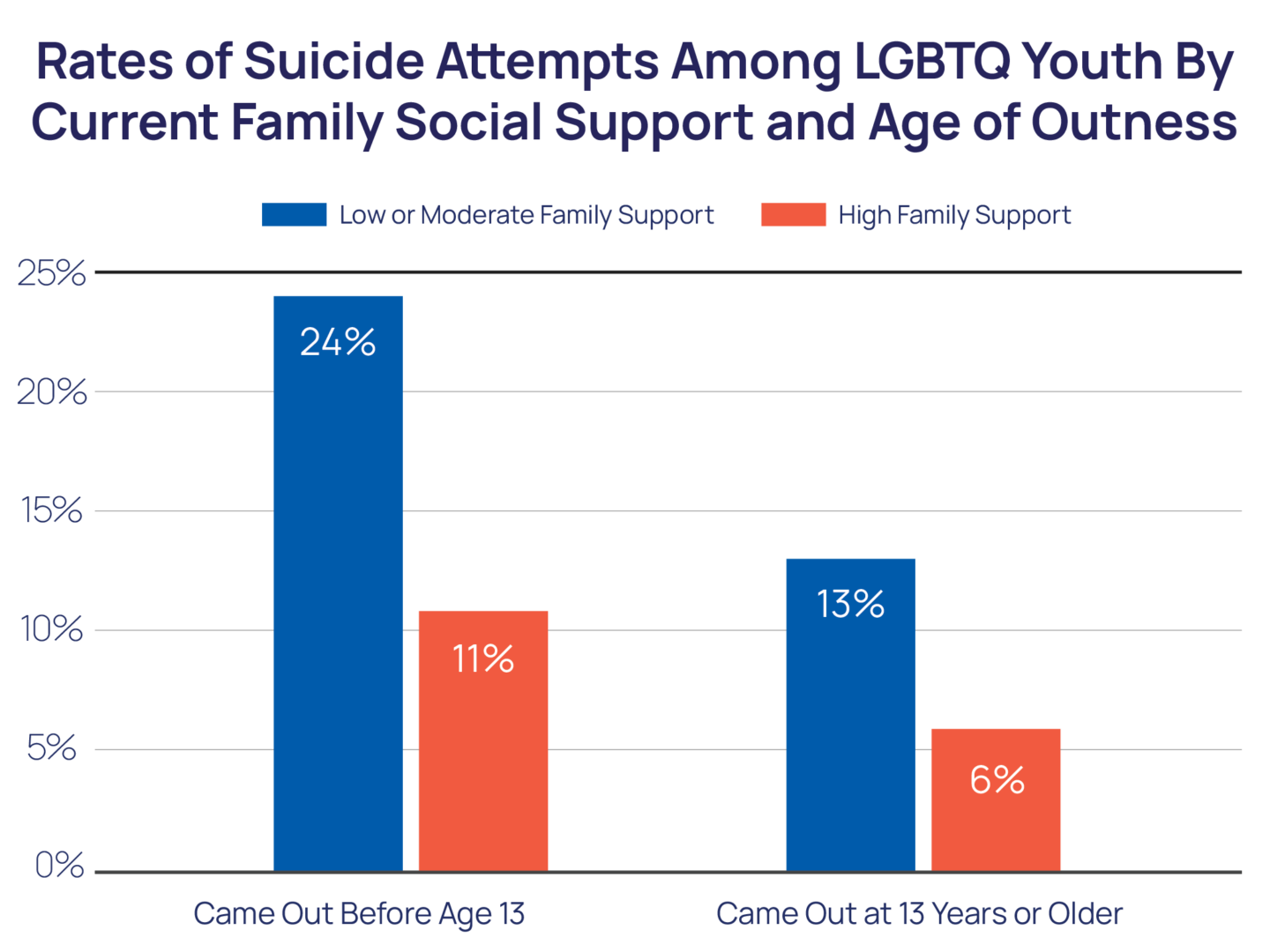
LGBTQ youth who came out about their sexual orientation before age 13 and had high family support reported lower rates of attempting suicide in the past year. LGBTQ youth who came out before age 13 and had current high social support from their family reported half the rate of attempting suicide (11%) compared to LGBTQ youth who came out before age 13 and had current low or moderate social support from their family (24%).
LGBTQ youth who came out about their sexual orientation two or more years after first thinking they might be LGBTQ had a 56% increased odds of attempting suicide in the past year (aOR=1.56). Coming out early may be associated with increased rates of victimization; however, delaying the coming out process may also have mental health implications. LGBTQ youth who came out within a year of realizing they may be LGBTQ reported lower rates of attempting suicide in the past year (12%), compared to LGBTQ youth who came out two or more years after realizing they might be LGBTQ (16%).
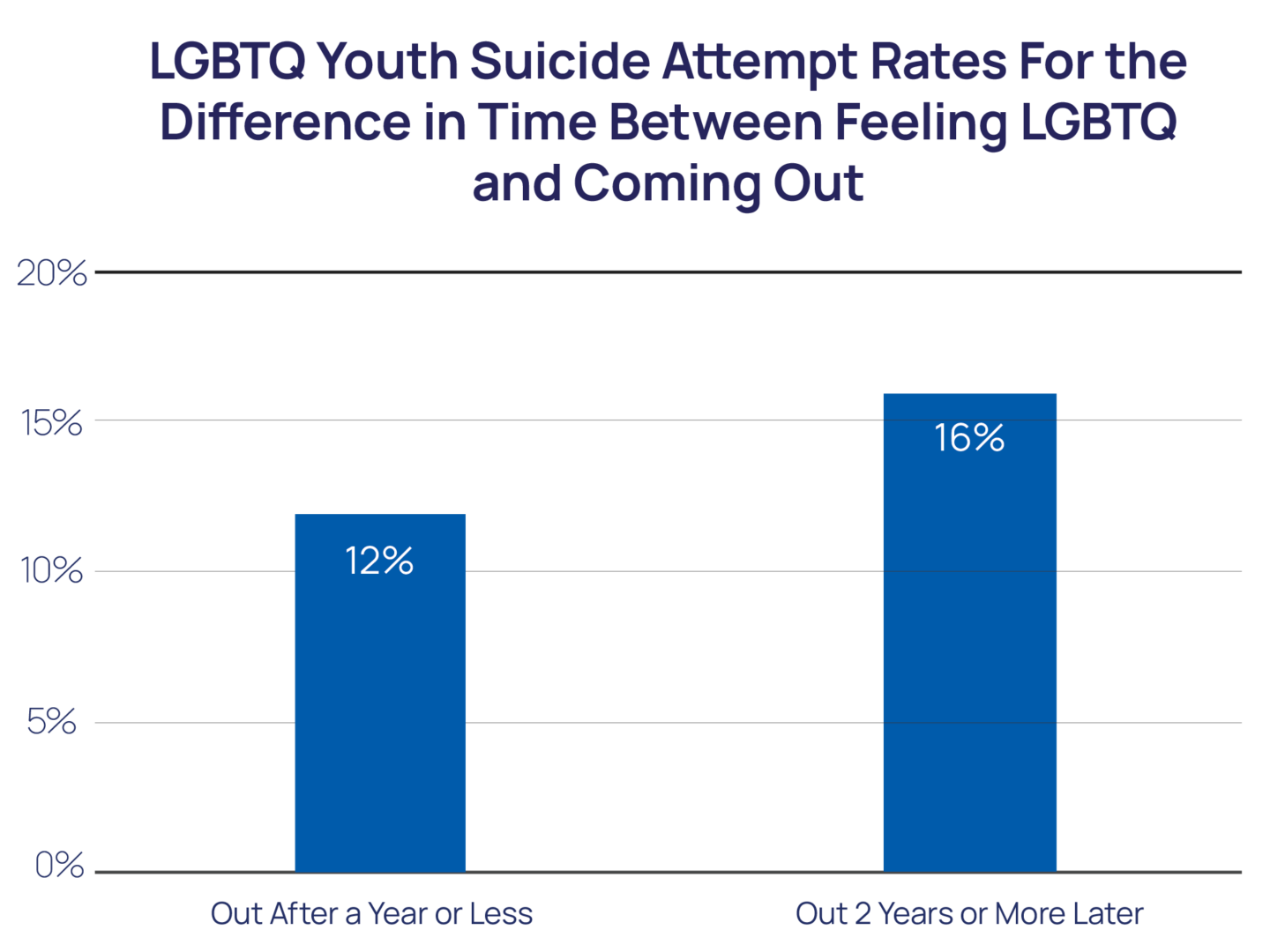
Methods
Data were collected from an online survey conducted between September and December 2021 of 33,993 LGBTQ youth recruited via targeted ads on social media. Youth reported the age they first begin to think that they might be gay, lesbian, bisexual, queer, pansexual, or asexual, as well as the age they were first open (out) to others about their sexual orientation. The questions assessing suicide risk were taken from the Centers for Disease Control and Prevention’s Youth Risk Behavior Survey (Johns et al., 2020). Two separate adjusted logistic regression models were conducted to determine 1) the association between coming out before age 13 age and attempting suicide in the past year and 2) the association between delayed coming out and attempting suicide in the past year, while controlling for age, race/ethnicity, sex assigned at birth, gender identity, and sexual identity in both.
Looking Ahead
LGBTQ youth are not inherently prone to poor mental health and suicide risk because of their LGBTQ identity but rather placed at higher risk because of the stigma and mistreatment they face on the basis of their identity (Meyer, 2003). While we have certainly made significant legal and social strides in society, LGBTQ youth still face higher rates of victimization. These findings support previous research that LGBTQ youth are reaching coming out milestones at younger ages than in previous years (Meyer et al., 2021). They also show that coming out younger may be putting youth at risk for victimization and, in turn, contributing to an increased risk for suicide. Indeed, previous research finds that LGBTQ youth in middle school report higher rates of bullying even compared to LGBTQ youth in high school (The Trevor Project, 2021). While older LGBTQ youth may continue to experience victimization, they also have other protective factors that may not be available to younger LGBTQ youth to buffer the impact, including increased access to LGBTQ-affirming environments and people, and more autonomy to seek them out.
These findings further convey that coming out in and of itself is not harmful to youth, at any age. Rather, it is the harmful environments in which LGBTQ youth find themselves that contribute to the negative outcomes we see. Overall, this suggests that instead of insisting that younger LGBTQ youth not come out for fear of exposure to bullying and harassment, the people in their lives should create environments in which they can do so safely. This is particularly true given that choosing to delay coming out, for a variety of valid reasons, was also associated with increased suicide risk. The constant is that LGBTQ youth who have support from others report better outcomes, suggesting that parents and family members, teachers, school administrators, and other direct service providers must ensure that the spaces LGBTQ youth find themselves in are affirming and supportive of their identities. For example, they can help advocate for and implement LGBTQ-inclusive school policies, from zero tolerance for anti-LGBTQ bullying and harassment and bystander intervention training to non-discrimination protections and suicide prevention policies and classroom curricula that reflect the experiences of LGBTQ students.
As we celebrate the 34th annual National Coming Out Day, the Trevor Project supports and affirms that every youth’s decision to come out or not is a personal decision, and there is no right or wrong way to do it. Our Coming Out Handbook provides youth with tools and guiding questions to help them navigate their identity — as well as what it might be like to share it with others. We have outlined various ways parents and caregivers can be affirming and supportive of the LGBTQ young people in their lives in our previous brief, Behaviors of Supportive Parents and Caregivers for LGBTQ Youth. Furthermore, our Guide to Being an Ally to Transgender and Nonbinary Youth offers specific educational resources on how to best support transgender and nonbinary young people. Our 24/7 crisis services are available in three different modalities – phone, chat, and text – for youth to connect with affirming counselors when they are in crisis. Our TrevorSpace platform also connects youth with supportive peers. Further, Trevor’s research and advocacy teams are focused on using data to advance LGBTQ-inclusive policies and practices and empower youth-serving professionals with the knowledge necessary to understand and address these young people’s unique mental health needs.
References
- Feinstein, B.A., Mereish, E.H., Mamey, M. R., Chang, C J., & Goldbach, J.J. (2022) Age differences in the associations between outness and suicidality among LGBTQ+ youth. Archives of Suicide Research, DOI: 10.1080/13811118.2022.2066493
- Johns, M. M., Lowry, R. R., Haderxhanaj, L. T., Rasberry, C., Robin, L., Scales, L., Stone, D., Suarez, N., & Underwood, J. M. (2020). Trends in violence victimization and suicide risk by sexual identity among high school students — youth risk behavior survey, United States, 2015–2019. MMWR Morbidity Mortality Weekly Report, 69(Suppl-1), 19–27. http://dx.doi.org/10.15585/mmwr.su6901a3
- Kosciw, J.G., Palmer, N.A., & Kull, R.M. (2015). Reflecting resiliency: Openness about sexual orientation and/or gender identity and its relationship to well-being and educational outcomes for LGBT students. American Journal of Community Psychology, 55, 167–178. doi: 10.1007/s10464-014-9642-6.
- Meyer, I. H. (2003). Prejudice, social stress, and mental health in lesbian, gay, and bisexual populations: Conceptual issues andresearch evidence. Psychological Bulletin, 129(5), 674–697.
- Meyer, I. H., Blosnich, J. R., Choi, S. K., Harper, G. W., & Russell, S. T. (2021). Suicidal behavior and coming out milestones in three cohorts of sexual minority adults. LGBT Health, 8(5), 340–348. https://doi.org/10.1089/lgbt.2020.0466
- Poteat, V. P., Watson, R. J., & Fish, J. N. (2021). Teacher support moderates associations among sexual orientation identity outness, victimization, and academic performance among LGBQ + Youth. Journal of Youth and Adolescence, 50(8), 1634–1648. https://doi.org/10.1007/s10964-021-01455-7.
- The Trevor Project (2021). Bullying and suicide risk among LGBTQ youth. The Trevor Project.
For more information please contact: [email protected]